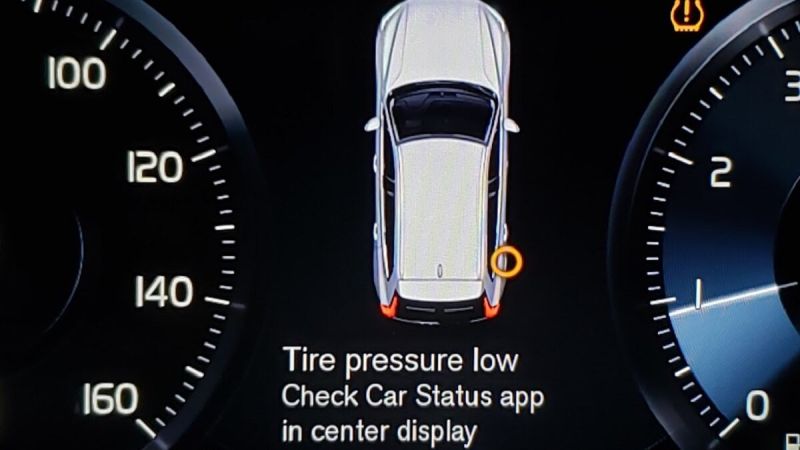Fall has arrived, and with it dropping temperatures. The air inside your tires may well have been added at your last service visit and is now likely lower in pressure due to the lower temps. This is a law of physics, and it makes no difference if you paid for nitrogen-filled tires or have normal air (which is mostly nitrogen). Once the temperatures drop enough, the air pressure will come down to the tire pressure monitor’s (TMPS’s) setpoint, and you will get an alert.
Of course, if you see a low tire pressure or TPMS warning light, you may indeed have a tire puncture or tire damage. Here is what to do if you get a TPMS warning light.
Step One - If You See a Low Pressure Tire Warning Light (TPMS)
If you get a warning on your dash about low tire pressure, take it seriously. Drive to the nearest safe place to stop. That was easy, wasn’t it?
Step Two - If You See a Low Pressure Tire Warning Light (TPMS)
Once you have stopped, look closely at your information display. Does it tell you which tire is of concern? Some cars do, and some just have the warning. If there is more information, what does it say? Does it say, “Left rear tire is low?” or something to that effect? If so, ad if it displays the pressure, what is the pressure? If you drive a normal car and the pressure is above 20 psi, you likely don’t have a puncture. It is most likely just a pressure drop. If the pressure is under 20 psi, you probably do have a flat.
Step Three - If You See a Low Pressure Tire Warning Light (TPMS)
If your pressure is not displayed or is below 20 psi, roll down your driver’s window and turn off the car. The driver’s window being down will ensure you cannot possibly lock yourself out of the car. Walk around your car and look closely at each tire. Look at the one that is reported to be low and see if you can see any damage. If so, consider your options (we will help in a minute). If there is no visible damage, move the car a bit so you can see the spot under the tire when you were parked and look again.
Step Four - If You See a Low Pressure Tire Warning Light (TPMS)
If you have damage and the tire is low, call for roadside assistance to help you. If you have run-flat-capable tires, consult your manual. If you do have run-flat capable tires, and you only need to drive less than 50 miles and can do it at speeds under 50 mph, you can drive to your destination.
If you have self-sealing tires (like on a Chevy Bolt or Ford Explorer), consult your manual. You may be able to inflate the tires and carry on until you can get to a tire repair shop.
Most cars don’t have run flats or self-sealing tires. If you can’t see any damage and the tire appears NOT to be flat, use a pressure gauge to determine what the pressure is. If all the tires are above 20 psi, you can pump them up to the proper setpoint. You can find the proper setpoint on your driver’s door jam.
Step Five - If You See a Low Pressure Tire Warning Light (TPMS)
If you just needed to top off the air, you are all set. Consult your manual about resetting the TPMS warning. If you have a flat, call AAA or your roadside assistance provider (perhaps it is from your automobile maker, insurer, or your extended warranty provider) and tell them the situation. If you have a spare, they can mount it. If you don’t, they will likely tow you.
Bonus Step - If You See a Low Pressure Tire Warning Light (TPMS)
Some cars have a tire mobility kit, a.k.a. Tire sealant and a pump, a.k.a. “Gunk in the trunk” that can help you to seal a puncture ad then re-inflate the tire. Follow the instructions in your owner’s manual if you have confirmed you have an actual puncture.
If you don’t already own a set, get a compact 12 VDC air pump for your trunk and a good-quality pressure gauge. You can get both for about $50 online. These are valuable tools, and your car most likely didn’t come with them. Check your tire pressure monthly either using your in-vehicle display or your tire gauge.
Happy motoring.
Image of TPMS Low Tire Pressure Warning Light by John Goreham
John Goreham is a long-time New England Motor Press Association member and recovering engineer. John's interest in EVs goes back to 1990 when he designed the thermal control system for an EV battery as part of an academic team. After earning his mechanical engineering degree, John completed a marketing program at Northeastern University and worked with automotive component manufacturers, in the semiconductor industry, and in biotech. In addition to Torque News, John's work has appeared in print in dozens of American news outlets and he provides reviews to many vehicle shopping sites. You can follow John on TikTok @ToknCars, on Twitter, and view his credentials at Linkedin












Comments
At point where I needed help…
Permalink
At point where I needed help, "resetting the TPMS," you sent me to the user's manual. Thanks. Some vehicles have an easy reset. Others complicated and that's where we need help.